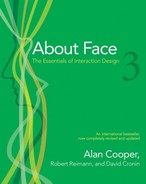0%
39Chapters
0-1Hours read
0kTotal Words
Book Description
This completely updated volume presents the effective and practical tools you need to design great desktop applications, Web 2.0 sites, and mobile devices. You’ll learn the principles of good product behavior and gain an understanding of Cooper’s Goal-Directed Design method, which involves everything from conducting user research to defining your product using personas and scenarios. Ultimately, you’ll acquire the knowledge to design the best possible digital products and services.
Table of Contents
- Copyright
- About the Authors
- Credits
- Foreword: The Postindustrial World
- Acknowledgments
- Introduction to the Third Edition
- I. Understanding Goal-Directed Design
- 1. Goal-Directed Design
- Digital Products Need Better Design Methods
- The Evolution of Design in Manufacturing
- Planning and Designing Behavior
- Recognizing User Goals
- The Goal-Directed Design Process
- 2. Implementation Models and Mental Models
- 3. Beginners, Experts, and Intermediates
- 4. Understanding Users: Qualitative Research
- Qualitative versus Quantitative Research
- Ethnographic Interviews: Interviewing and Observing Users
- Other Types of Research
- Notes
- 5. Modeling Users: Personas and Goals
- Why Model?
- Personas
- Strengths of personas as a design tool
- Personas are based on research
- Personas are represented as individual people
- Personas represent groups of users
- Personas explore ranges of behavior
- Personas must have motivations
- Personas can also represent nonusers
- Personas and other user models
- When rigorous personas aren’t possible: Provisional personas
- Goals
- Constructing Personas
- Step 1: Identify behavioral variables
- Step 2: Map interview subjects to behavioral variables
- Step 3: Identify significant behavior patterns
- Step 4: Synthesize characteristics and relevant goals
- Step 5: Check for completeness and redundancy
- Step 6: Expand description of attributes and behaviors
- Step 7: Designate persona types
- Other Models
- Notes
- 6. The Foundations of Design: Scenarios and Requirements
- 7. From Requirements to Design: The Framework and Refinement
- The Design Framework
- Defining the interaction framework
- Defining the visual design framework
- Defining the industrial design framework
- Refining the Form and Behavior
- Design Validation and Usability Testing
- Notes
- The Design Framework
- 1. Goal-Directed Design
- II. Designing Behavior and Form
- 8. Synthesizing Good Design: Principles and Patterns
- 9. Platform and Posture
- 10. Orchestration and Flow
- 11. Eliminating Excise
- 12. Designing Good Behavior
- Designing Considerate Products
- Considerate products take an interest
- Considerate products are deferential
- Considerate products are forthcoming
- Considerate products use common sense
- Considerate products anticipate human needs
- Considerate products are conscientious
- Considerate products don’t burden you with their personal problems
- Considerate products keep us informed
- Considerate products are perceptive
- Considerate products are self-confident
- Considerate products don’t ask a lot of questions
- Considerate products fail gracefully
- Considerate products know when to bend the rules
- Considerate products take responsibility
- Designing Smart Products
- Designing Considerate Products
- 13. Metaphors, Idioms, and Affordances
- 14. Visual Interface Design
- Art, Visual Interface Design, and Other Design Disciplines
- The Building Blocks of Visual Interface Design
- Principles of Visual Interface Design
- Use visual properties to group elements and provide clear hierarchy
- Provide visual structure and flow at each level of organization
- Use cohesive, consistent, and contextually appropriate imagery
- Integrate style and function comprehensively and purposefully
- Avoid visual noise and clutter
- Keep it simple
- Text in visual interfaces
- Color in visual interfaces
- Visual interface design for handhelds and other devices
- Principles of Visual Information Design
- Consistency and Standards
- III. Designing Interaction Details
- 15. Searching and Finding: Improving Data Retrieval
- 16. Understanding Undo
- 17. Rethinking Files and Save
- 18. Improving Data Entry
- 19. Pointing, Selecting, and Direct Manipulation
- 20. Window Behaviors
- 21. Controls
- 22. Menus
- 23. Toolbars
- 24. Dialogs
- 25. Errors, Alerts, and Confirmation
- 26. Designing for Different Needs
- Afterword: On Collaboration
- A. Design Principles
- B. Bibliography
